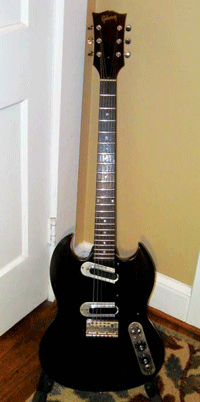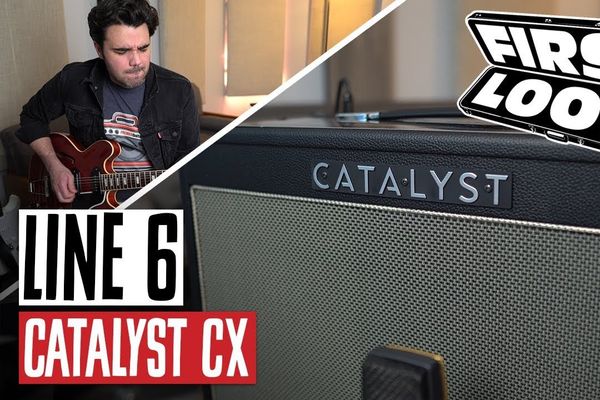
Gibson''s short-lived, larger bodied SG made an appearance in the early ''70s
Dear Trash or Treasure:
This odd Gibson guitar was purchased sometime in the 1970s and, as far as I can tell, is all original. I think it is an SG because of the body style, but I have never seen another one like it with these pickups. I have the original case, but the bridge cover appears to be missing. The serial number is 972190 and it has “Made In USA” and a “2” stamped under the number. I’m not planning on selling this guitar, but I would like to know what it is and what it is worth.
Thanks!
Woody
Silver Spring, Maryland
Hey, Woody.
You’re right, this is an SG. And there’s a reason you don’t see many of these guitars: the SG-100, SG-200, and SG-250 were only produced for a little over a year in the early 1970s! Many Gibson enthusiasts agree that the 1970s were a dark period for Gibson guitar production, and most players and collectors don’t seek out these guitars. However, the SG continues to be a successful guitar for Gibson, and many performers have used them, including Tony Iommi, Pete Townshend, and, most notably, Angus Young of AC/DC.
The SG body style goes back to 1958, when Gibson redesigned the Les Paul Junior with its first-ever double-cutaway solidbody. At the time, the single-cutaway Les Paul wasn’t selling as well as Gibson had hoped, so the company planned to apply this new rounded double-cutaway style to the entire line. By 1960, the Junior and Special were renamed as SGs, which stood for “solid guitar.” According to folklore, SG was a temporary term for the body style, but Gibson never came up with another name and SG stuck.
In late 1961, Gibson introduced a different double- cutaway with pointed, beveled bouts that became the SG body style we know today. This new body style was applied to all Les Paul models available at the time, and they were labeled Les Pauls until 1963, when Gibson and Les Paul temporarily parted ways. Paul was never too crazy about the new design of the Les Paul model, and he didn’t renew the contract to use his name on three of Gibson’s guitars. In 1968, the Les Paul was reintroduced with the traditional single-cutaway design, but Gibson continued production of the SG as well. Ted McCarty left Gibson in 1966, which is widely known as the start of a downhill slide in Gibson’s production quality. By the 1970s, Gibson was beginning to experiment in research and development, and your guitar is a product of this experimentation.
Gibson discontinued the Melody Maker series in 1970 and replaced it in late 1971 with three new SG models, all sharing the same body and features: the SG-100, SG-200, and SG-250. Gibson steered away from traditional designs in these guitars, using a slightly larger body shape, no neck pitch, and single-coil pickups. Looking back, all these new features were essentially downgrades. While the body became more durable with maple construction, it was heavier and bulkier to play. The fingerboard, strings, and top of the body became parallel with each other, resulting in a high action over the body. The single-coil pickups sounded thin and tinny compared to humbuckers and P-90s. This new series wasn’t very well received and was quickly replaced in late 1972 with the SG-I, SG-II, and SG-III.
The SG-100, SG-200, and SG-250 all share these common features: maple body (mahogany has also been observed), set maple neck, 22-fret rosewood fingerboard with dot inlays, black headstock overlay with gold Gibson logo, three-per-side Kluson tuners with small buttons, Tune-o-matic bridge with an odd connected base plate and bridge cover, single-coil Melody Maker-style pickups with black covers inscribed with “Gibson,” and an angled control plate with Volume and Tone knobs. The SG-100 has a single pickup and was available in cherry or walnut finish. The SG-200 has two pickups with two slide switches and was available in black, cherry, or walnut finish. The SG-250 is identical to the SG-200 in electronics and construction, but features a cherry sunburst finish.
According to Gibson’s shipping records, just over 5,000 SG-100, SG-200, and SG-250s were shipped during their short production in 1971 and 1972. Serialization is not a very useful dating tool from this era, but it is likely that your guitar was made in 1971. A total of 2,448 SG-200s were produced in walnut finish, but only 23 were shipped in 1972. The “2” under the serial number indicates that the guitar was a factory second, meaning there was a flaw in the wood or finish. Instead of discarding the guitar, Gibson sold it at a discounted price with a full factory warranty. Today, your guitar is worth between $800 and $1000, as it appears to be in excellent condition. The SG-200 is not valued nearly what some of Gibson’s classics are today, but it is a Gibson nonetheless and an important part of their heritage and history. Perhaps more collectors and players will take notice of this guitar as the ’50s and ’60s models become more rare and expensive.
Zachary R. Fjestad
Zachary is the author of the Blue Book of Acoustic Guitars, Blue Book of Electric Guitars, and the Blue Book of Guitar Amplifiers. Questions can be submitted to: Blue Book Publications Attn: Guitar Trash or Treasure 8009 34th Ave. S. Ste #175 Minneapolis, MN 55425
bluebookinc.com
guitars@bluebookinc.com
This odd Gibson guitar was purchased sometime in the 1970s and, as far as I can tell, is all original. I think it is an SG because of the body style, but I have never seen another one like it with these pickups. I have the original case, but the bridge cover appears to be missing. The serial number is 972190 and it has “Made In USA” and a “2” stamped under the number. I’m not planning on selling this guitar, but I would like to know what it is and what it is worth.
Thanks!
Woody
Silver Spring, Maryland
Hey, Woody.
You’re right, this is an SG. And there’s a reason you don’t see many of these guitars: the SG-100, SG-200, and SG-250 were only produced for a little over a year in the early 1970s! Many Gibson enthusiasts agree that the 1970s were a dark period for Gibson guitar production, and most players and collectors don’t seek out these guitars. However, the SG continues to be a successful guitar for Gibson, and many performers have used them, including Tony Iommi, Pete Townshend, and, most notably, Angus Young of AC/DC.
The SG body style goes back to 1958, when Gibson redesigned the Les Paul Junior with its first-ever double-cutaway solidbody. At the time, the single-cutaway Les Paul wasn’t selling as well as Gibson had hoped, so the company planned to apply this new rounded double-cutaway style to the entire line. By 1960, the Junior and Special were renamed as SGs, which stood for “solid guitar.” According to folklore, SG was a temporary term for the body style, but Gibson never came up with another name and SG stuck.
In late 1961, Gibson introduced a different double- cutaway with pointed, beveled bouts that became the SG body style we know today. This new body style was applied to all Les Paul models available at the time, and they were labeled Les Pauls until 1963, when Gibson and Les Paul temporarily parted ways. Paul was never too crazy about the new design of the Les Paul model, and he didn’t renew the contract to use his name on three of Gibson’s guitars. In 1968, the Les Paul was reintroduced with the traditional single-cutaway design, but Gibson continued production of the SG as well. Ted McCarty left Gibson in 1966, which is widely known as the start of a downhill slide in Gibson’s production quality. By the 1970s, Gibson was beginning to experiment in research and development, and your guitar is a product of this experimentation.
Gibson discontinued the Melody Maker series in 1970 and replaced it in late 1971 with three new SG models, all sharing the same body and features: the SG-100, SG-200, and SG-250. Gibson steered away from traditional designs in these guitars, using a slightly larger body shape, no neck pitch, and single-coil pickups. Looking back, all these new features were essentially downgrades. While the body became more durable with maple construction, it was heavier and bulkier to play. The fingerboard, strings, and top of the body became parallel with each other, resulting in a high action over the body. The single-coil pickups sounded thin and tinny compared to humbuckers and P-90s. This new series wasn’t very well received and was quickly replaced in late 1972 with the SG-I, SG-II, and SG-III.
The SG-100, SG-200, and SG-250 all share these common features: maple body (mahogany has also been observed), set maple neck, 22-fret rosewood fingerboard with dot inlays, black headstock overlay with gold Gibson logo, three-per-side Kluson tuners with small buttons, Tune-o-matic bridge with an odd connected base plate and bridge cover, single-coil Melody Maker-style pickups with black covers inscribed with “Gibson,” and an angled control plate with Volume and Tone knobs. The SG-100 has a single pickup and was available in cherry or walnut finish. The SG-200 has two pickups with two slide switches and was available in black, cherry, or walnut finish. The SG-250 is identical to the SG-200 in electronics and construction, but features a cherry sunburst finish.
According to Gibson’s shipping records, just over 5,000 SG-100, SG-200, and SG-250s were shipped during their short production in 1971 and 1972. Serialization is not a very useful dating tool from this era, but it is likely that your guitar was made in 1971. A total of 2,448 SG-200s were produced in walnut finish, but only 23 were shipped in 1972. The “2” under the serial number indicates that the guitar was a factory second, meaning there was a flaw in the wood or finish. Instead of discarding the guitar, Gibson sold it at a discounted price with a full factory warranty. Today, your guitar is worth between $800 and $1000, as it appears to be in excellent condition. The SG-200 is not valued nearly what some of Gibson’s classics are today, but it is a Gibson nonetheless and an important part of their heritage and history. Perhaps more collectors and players will take notice of this guitar as the ’50s and ’60s models become more rare and expensive.
Zachary R. Fjestad
Zachary is the author of the Blue Book of Acoustic Guitars, Blue Book of Electric Guitars, and the Blue Book of Guitar Amplifiers. Questions can be submitted to: Blue Book Publications Attn: Guitar Trash or Treasure 8009 34th Ave. S. Ste #175 Minneapolis, MN 55425
bluebookinc.com
guitars@bluebookinc.com
From Your Site Articles
- Gleaming White 3-Pickup Dynamite - Premier Guitar ›
- Gibson Unveils the Tony Iommi SG Special - Premier Guitar ›
- Gibson Gives Announces the TEMPO Program - Premier Guitar ›
- Gibson Partners with Billie Joe To Create His Les Paul Jr - Premier Guitar ›
- Gibson Brands Announces CEO Transition - Premier Guitar ›
